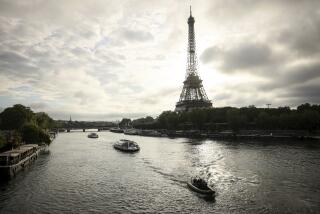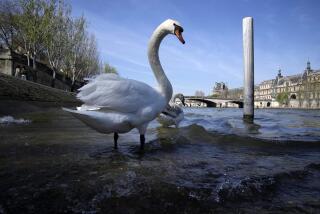A Seine Existence : Lifestyles: Abandoning his apartment for a boat gave Mort Rosenblum a fresh view of Paris--and served as fodder for his new book.
- Share via
PARIS — Mort Rosenblum emerged from the hold of his bateau on a fine spring morning, wiping grease from his hands and taking in the mesmerizing view of the Eiffel Tower.
He stood on the deck barefoot, hair askew, dressed in a T-shirt and ripped, paint-splotched jeans. A fine picture, indeed, for the boatloads of tourists passing every few minutes, producing swells on the Seine that gently rocked Rosenblum’s home.
“You’re like an orangutan in a zoo here,” he says later, with a shrug. “After a while, you don’t even see the tourists.”
Right in the heart of one of the most beautiful cities in the world, just steps from the Grand Palais and the Place de la Concorde, this 50-year-old American has discovered a tranquil paradise aboard a 54-foot boat docked on the bank of the Seine.
“This is a whole different Paris,” says Rosenblum, a Tucson-born journalist and Paris resident for 17 years. “Every minute, it’s different--from the rosy dawn, when all I can hear are the ducks quacking, to sunset, when the pastel colors of Paris appear. It’s like having a country place.”
This onetime landlubber’s love affair with the Seine is the subject of “The Secret Life of the Seine,” a sentimental portrait of France’s most important river and of the people--such as Rosenblum--who live on it and beside it.
“Secret Life” is a departure for the author, an Associated Press special correspondent whose seven previous books have concerned rather weightier subjects, from African economic development to the French abortion pill to the quality of foreign news reporting. But this time he’s pushing into territory that is closer to, well, home. And, he says, “this is the first time I’ve had this much fun writing a book.”
This book, like most of his others, was written on the boat he fondly and respectfully calls La Vieille , the Old Lady. To be more specific, it was written below deck, in the rocking main cabin that shines with his latest coat of varnish.
Sipping coffee on Rosenblum’s deck, looking up at the Eiffel Tower and the golden statues atop the Alexander III bridge, watching the dark waters of the Seine race past, it’s hard not to fall head over heels for the lifestyle.
Here, at the axis of a metropolitan area of 8 million people, is a Paris few Parisians could imagine, an intoxicating combination of breathtaking beauty and solitude.
This is a habitation fantasy that “is a long way downstream from shabby,” as Doonesbury creator Garry Trudeau observes on the book jacket.
When Rosenblum moved onto the boat in 1987, after 10 years of Parisian apartment life, he discovered “a whole different Paris,” he says.
“It was as if I’d never seen Paris before. I had no clue. You can walk by this three times a day and not begin to imagine how lovely it is. Here is a Paris where you actually like Parisians.”
Therein lies a problem, though. Another habitation fantasy book, Peter Mayle’s wildly successful “A Year in Provence,” sent hordes of tourists into that bucolic region of France, ruining the very serenity the book promised. It is said that Mayle’s book, his sequel and a British television program based on them have been so successful that the author is no longer welcome in some quarters in Provence.
Similar thoughts occurred to Rosenblum’s neighbors when he told them that he was writing a book. “Be sure to tell them about floods and leaks,” he was urged by one neighbor, identified only as Philippe in the book. (One has to walk across Philippe’s boat to get to Rosenblum’s.)
“Boat people are not wildly hospitable,” Rosenblum admits. Like those animals in the zoo, they know they are on display, he says, “but it is unhealthy to get too close.”
Just to be safe, Rosenblum identifies his boat in the book only by its La Vieille nickname, rather than by the legal name printed on the boat’s bow.
“The neighbors would probably sink my boat if my book brought a bunch of people here,” he says.
*
To be sure, people who live on the Seine belong to a small fraternity with a limited membership. Only about 50 boats are licensed to be moored in Rosenblum’s neck of the Seine, and there isn’t room for more.
Also, as Rosenblum’s neighbor suggested, life on the river has its ups and downs. When the river floods, as it did during Christmas last year, boat dwellers put on waders, hoist briefcases above their heads and walk carefully through the racing current to a rowboat, which they then must take to get home.
“On the surface, this life looks great, I know,” says Rosenblum, who shares the boat with a companion, Jeannette, to whom he has dedicated the book. “A romantic, carefree existence. And in a lot of ways it is.
“But you also can be sipping wine on the deck and all of a sudden hear a crash because a log has run into your boat. And then you spend the next two hours on your belly with a flashlight, trying to dislodge the log.”
While the Seine may be, as Rosenblum says, “a separate arrondissement of the spirit,” it also is, again in his words, “a time-eating lesson in uniqueness.”
La Vieille began its life on water at the turn of the century, as an admiral’s craft in the British Royal Navy. The boat, which has three small rooms plus a tiny kitchen and bath, is powered by engines similar to those that propel London’s taxis. As with all aging boats, leaks and repair work are constants. And it can be hugely expensive if one is careless or even just unlucky.
“If the life is often privileged, boat dwellers pay for it,” Rosenblum says.
Boat dwellers do stick together, even if they aren’t exactly friends. Rosenblum remembers how he arrived home after particularly heavy rains one evening to find several neighbors, total strangers, standing hip-deep in the rushing Seine, gripping the lines of La Vieille. They had been there for three hours.
“Had it not been for them, my boat would have been toothpicks,” Rosenblum says. “You’re like blood brothers here. It’s something from the caveman age. You depend on each other for survival.”
Before he bought his boat, Rosenblum considered himself a “desert person,” with few handyman skills. Now he loves the water and owns a closetful of power tools that he knows how to use.
“This is the corny part,” he says, “but you get in touch with the real world here. Weather reports mean something to me now. A rain might mean I won’t be able to get to my boat. And a stiff wind might mean my deck chairs are going to blow off. You get to know water up close.”
The freedom of a boat dweller’s life may be the most intoxicating part of all. “In 10 minutes,” he said the other day, leaning on the teak wheel, “I could untie the moorings, and we go all the way to the Black Sea. All I’ve got to do is turn on the engine. That you can’t do in an apartment.”
Like any good seaman, Rosenblum has fallen in love with the 15-foot deep river on which his home floats. He knows its boats and many of its captains. For his book, he traced the river’s ancient history and tracked the river itself, beginning with its first clear trickle near Dijon to the point, 482 miles later, where it disgorges into the English Channel.
“Two millennia ago, the Seine was like chicken soup,” he says. “Anything that was wrong with you, you drank water from the Seine to cure it.”
That certainly has changed. The level of bacteria in the Seine is 100 times higher than the European safety standard, and it contains 57 varieties of dangerous pollutants.
“If you fall in, you might dissolve,” Rosenblum says, only half-joking. He had a cat that took a dive one night and recovered only after a two-week regimen of antibiotics.
But the ecological health of the Seine is the last thing on a boat dweller’s mind when the tour vessels have called it a day and the Eiffel Tower’s lights are doused. All that’s left then are the whispers of the river water and the people who live on it.
“On summer nights here,” Rosenblum says dreamily, “sometimes you just forget to go to bed.”
More to Read
Sign up for our Book Club newsletter
Get the latest news, events and more from the Los Angeles Times Book Club, and help us get L.A. reading and talking.
You may occasionally receive promotional content from the Los Angeles Times.











